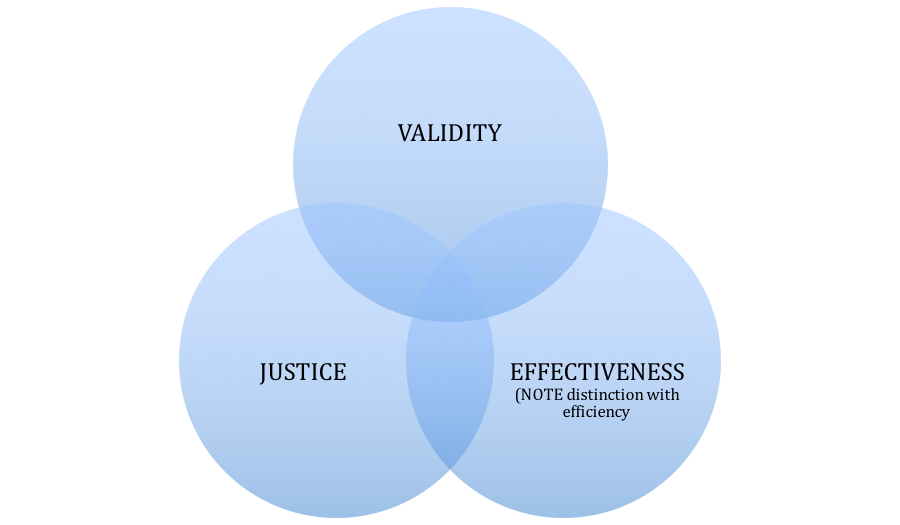Methodology Note
The following is part of the methodological preface of an academic work; taken from “A global solution for the protection of inventions“, pp. ix-xii. It describes the methodology used behind the TRIPS PLUS ULTRA proposal and the proposal in that book, obviously (to see how the methodology informed the proposal please click here).
“The analysis in this study is developed based upon a triple validation criteria of the examined regulation, intending to unravel the justice, validity, and effectiveness (aspects subsequently interconnected when determining the optimal incidence of a regulation on society) of the international patent legal system.[1] This legal three-dimensional analysis has been identified with various names, such as “legal trialism,” “three-dimensional conception of law,” “legal validation based on a triple criteria,” “triad of legal philosophy,” “trilogy: fact, value, and regulation,” and “criteria about justice, regulations, and facts,” among others. In the present study, the analysis of the regulations under the scrutiny of these three criteria will be referred to as legal trialism (a name that matches the one used by the Argentinian Werner Goldschmidt, another author who is attributed with the creation of this line of thought), considering that this expression briefly reflects the spirit of this manner of analyzing regulations.[2] Obviously this study acknowledges the existence of other appropriate terminology to identify the legal analysis under the previously mentioned criteria [Added text for this webpage: effectiveness is diferente than efficiency (and was treated so since the first publication), an analysis that came latter, within this ongoing study that is presented in this wikipedia-like stile in this webpage] Likewise, each of the criteria used for this three-dimensional analysis of rules (justice, validity, and effectiveness) has been referred to by various authors who have addressed the subject with different names. Thus, the criteria related to justice have been referred to as axiological aspect, recta ratio, deontic aspect, and value theory, among other terms. In the present study this criteria will be referred to with expressions like the axiological aspect, justice, justness, fairness, or righteousness, while recognizing the existence of other appropriate terminology to identify it. In the same way, the criteria that in this study is referred to as validity of the regulation, is often referred with terms like ontological aspect [compliance] or others. Finally the term effectiveness, which is used throughout this study, can be identified in other publications with expressions like sociological, factual, or legal reality element and phenomenological problem, among others [effectiveness is diferente than efficiency].
This study rests on the philosophy discussed briefly in this concept note, but it is not intended to delve into a thorough analysis of it.[3] Doing so would divert the attention from the study to be addressed—a global solution for the correction of inventions. It is enough to state that this study relies on the conceptions of this school of thought and that it subscribes to it. Therefore, a deeper analysis of this evolution of legal thought would not be necessary. As a pure theory of law positivist legal writer of continental Europe of the past century would only have needed to mention Kelsen and the pure theory of law in order to address a legal analysis, this study serves to acknowledge the stream of thought that inspires it.
Finally, because of its illustrative qualities, a graphical approach to the ultimate goal of legal trialism is presented next. Each of the criterions is represented with circles (validity, effectiveness, and justice), and therefore the regulation with an optimal impact on society (the one that is at the same time just, valid, and effective) [effectiveness is diferente than efficiency] is graphically identified in the space where the three circles superpose simultaneously:
 [1] The proposed analysis adheres to a relatively recent line of legal thought that seeks to overcome, some even claim that it manages to fuse, 3 traditional legal conceptions, which are: 1) Iusnaturalism (ius naturale), a classical school of legal thought focused on natural justice. 2) Realism, a 20th century Scandinavian school of thought (not related with American Legal Realism) concerned with the effectiveness of the rules. This last two are criticized for being single dimensional lines of thought (natural justice and effectiveness). 3) The two-dimensional rigid conception (is and ought) of Kelsen’s legal positivism, known as pure theory of law.
[1] The proposed analysis adheres to a relatively recent line of legal thought that seeks to overcome, some even claim that it manages to fuse, 3 traditional legal conceptions, which are: 1) Iusnaturalism (ius naturale), a classical school of legal thought focused on natural justice. 2) Realism, a 20th century Scandinavian school of thought (not related with American Legal Realism) concerned with the effectiveness of the rules. This last two are criticized for being single dimensional lines of thought (natural justice and effectiveness). 3) The two-dimensional rigid conception (is and ought) of Kelsen’s legal positivism, known as pure theory of law.
[2] Bobbio, perhaps the maximum exponent of the trialist legal philosophy, understands it as follows: “Actually, facing any regulation we can establish a triple order of problems: 1) if it is fair or unfair; 2) if it is valid or invalid; 3) if it is effective or ineffective. There are three different problems: the one of justice, the one of validity, and the one of effectiveness of the regulation.” (Bobbio 1992, 33).
[3] As stated by Mauricio Plazas, important “legal writers (just by mentioning them the importance of the theory is made visible) have adopted the tridimensional theory of law or have contributed with their work to the ultimate consolidation of the trialist doctrine: Gény, Roubier, Villarry, Lask, Radbruch, Welzel, Nawiasky, Kantorowickz, Stone, Hall, Bobbio, Lumia, Bagolina, Ricci, Frosini, Recaséns Siches, Legaz y Lacambra y Eduardo García Máynes, among others. A detailed and distributed enumeration by countries and schools of trialists authors or those who with their ideas have contributed to the tridimensional conception, can be found in the work of Julio O. Chiappini, “Trialism”, in Enciclopedia Jurídica Omeba, Appendix, vol. IV, Buenos Aires, Driskill, 1979, p. 571–575” (Plazas 1998, 129). Werner Goldshmidt, Argentinian author, Miguel Reale, Brazilian author, and Carlos Fernandez Sessarego, Peruvian author, should also be recognized as a part of those who have contributed to this evolution of thought.”

